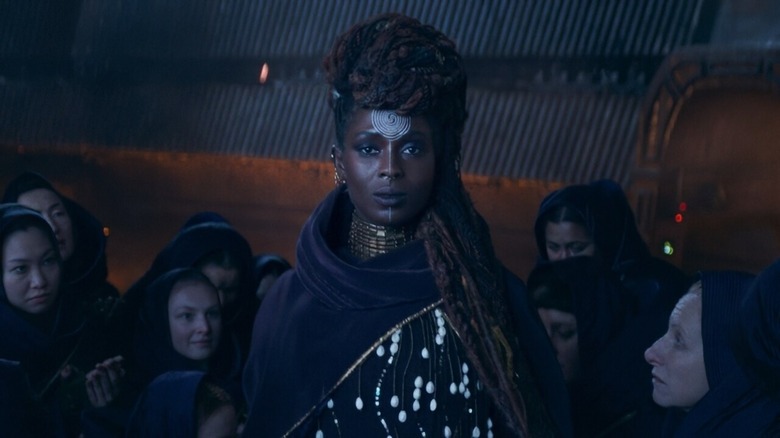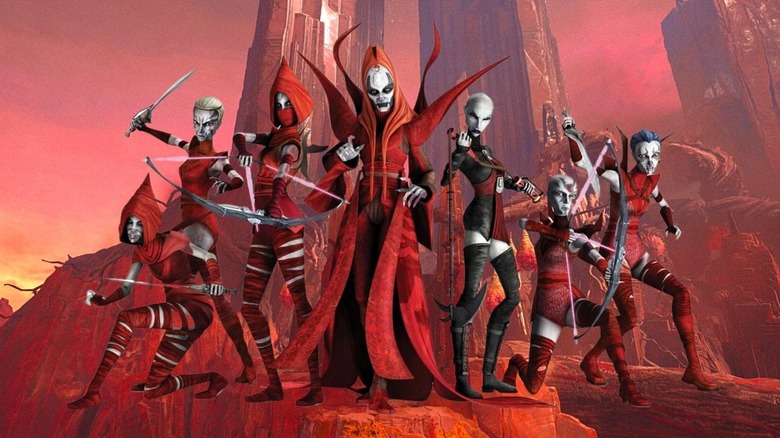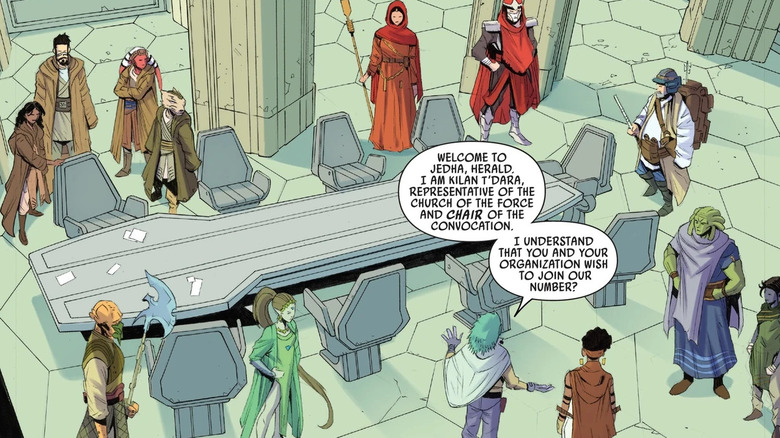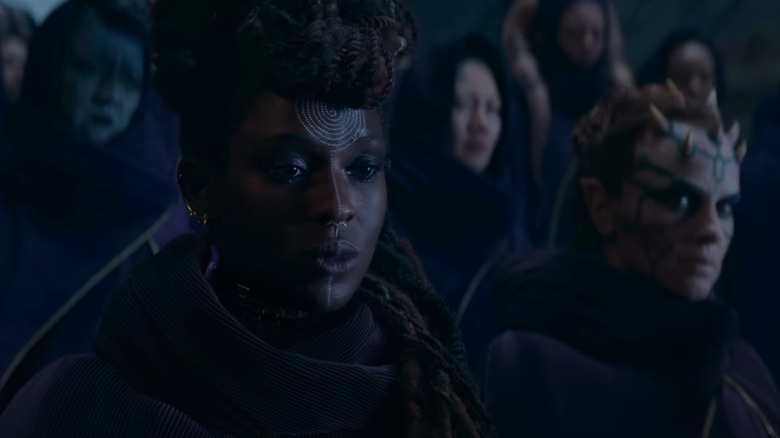Star Wars: The Acolyte's Coven Of Force Wielding Witches Has A Long Precedent
There will be spoilers for the third episode of "Star Wars: The Acolyte," so beware.
The third episode of "Star Wars: The Acolyte" transports us back in time 16 years to the days leading up to the tragedy that allowed Osha (played as an adult by Amandla Stenberg and as a child by Lauren & Leah Brady) to be taken by the Jedi and to assume her sister, Mae (played by the aforementioned acting trio) was dead. In the last episode, we watched Master Torbin die by suicide with the poison offered to him by Mae, rather than face the pain of living with the consequences of what happened that night sixteen prior. This episode shows us, from at least one point of view, what happened during that fateful encounter, but it also introduces us to the family of Mae and Osha.
Mae and Osha were born in a coven of witches led by Mother Aniseya (Jodie Turner-Smith), who somehow created them with the help of Mother Koril (Margarita Levieva) to carry them to term, but they did this all without a father. They are the only children in this mystical coven and all of them are being taught the Force in some way. They have chosen to live on the remote planet of Brendok, outside the reach of the Republic, in order to raise their children and train them. This training though, seems to have been outlawed by the Republic, putting them in trouble with the Jedi.
But this isn't the only coven of witches or Force users in "Star Wars" that haven't adhered to what we know about the Jedi and the Sith. We have had a long history of organizations like this in a galaxy far, far away, leaving precedent for Mother Aniseya's coven.
The Witches of Dathomir
The most obvious parallel to Aniseya's coven of witches on Brendok are the Witches of Dathomir, led by Mother Talzin. These witches are often clad in red, as opposed to the purple worn by Aniseya's sect. They also have a dark, green majick they use for their spells. Though they were first introduced to "Star Wars" in Dave Wolverton's 1994 Legends book "The Courtship of Princess Leia," they made the leap into canon with their inclusion in "Star Wars: The Clone Wars" and the character of Asajj Ventress. Adhering neither to the ways of the Jedi or the Sith, they live in isolation on Dathomir, much like the coven we see almost 100 years prior here in "The Acolyte."
Thanks to "Ahsoka," we know the Nightsisters of Dathomir originated outside the known galaxy and have spent many years in both places. At first, it seemed like Aniseya's witches could have been Nightsisters, but in an interview with IGN, showrunner Leslye Headland said the Nightsisters were definitely inspiration but they are not featured in the show. "'The Clone Wars' [inspired The Acolyte with] a lot being inspired by Nightsisters. We don't have any Nightsisters in this show, but being inspired by them, being inspired by Asajj Ventress."
The Convocation of the Force
There are other Force sects in the history of the galaxy too, and we've seen them on various other "Star Wars" shows and movies. "Star Wars Rebels" gave us a look at the Ashla with the Lasat and their beliefs of the Force. They also showed us the Bendu, a Force wielder beyond the binary of good and evil. In "Rogue One: A Star Wars Story" we were introduced to Jedha, a place of worship for many different sects of Force users, including the Guardians of the Whills. In "The Force Awakens," we got our first look at the Church of the Force.
Perhaps the best place to see all of the various Force-believing sects, though, is the Convocation of the Force, introduced in "The High Republic." This was a congress of Force sects all working together on Jedha to bring some understanding between each of the different flavors of Force worship. We were introduced to the Disciples of the Whills, the Fallanassi, and the Sorcerers of Tund, among others. (As a sidenote; the Sorcerors of Tund were first introduced to "Star Wars" in the early '80s through the novelized adventures of Lando Calrissian.)
Aside from those organizations, the Convocation of the Force is where we also found the Path of the Open Hand, an organization bent on the destruction of the Jedi that eventually turned into the marauding band of pirates known as the Nihil. In the third phase of "The High Republic," we still don't know the final disposition of the Nihil, but they have certainly made their mark on an uncertain galaxy.
The coven of Mother Aniseya and her adherents has a definite place in the fabric of "Star Wars" and shouldn't be taken to mean that they've come out of nowhere.
What happened since the time of the High Republic?
The way the Jedi treat Aniseya's sect and how they reference the laws of the Republic makes one think that things have changed drastically in the 100 years between the books of "The High Republic," set a century prior, and the current time this show is set. Since we don't know what happened to the Nihil definitively, it could be easy to assume that they are partly responsible for these new laws that would prevent the witches from training new children. There's a chance these witches could even be connected to the Nihil somehow, or any of the other sects that were part of the Convocation of the Force.
As I observed their similarities, I remembered the mountain clans of Dathomir introduced in "Tales of the Empire" earlier this year, and I also wondered if this could be some distant splinter group of the Nightsisters, though not the Nightsisters themselves.
Whatever Aniseya's sect ends up being, however, there is a firm precedent in the recent history of "Star Wars" for their existence, and they feel not just inspired by the Nightsisters, as Headland says, but intimately related to them. We'll just have to tune in to further episodes to learn more.
New episodes of "The Acolyte" debut on Disney+ on Tuesdays at 9:00pm ET.



